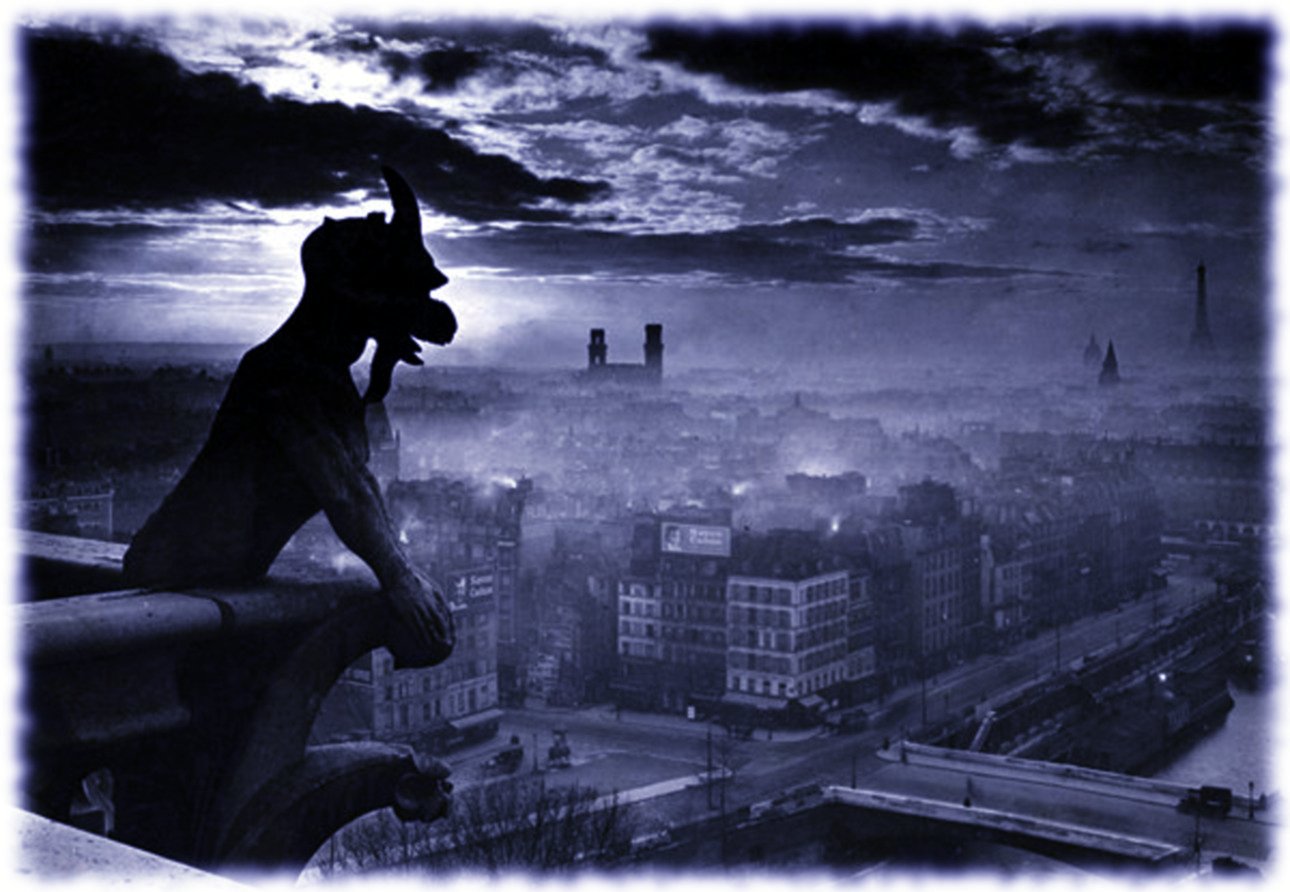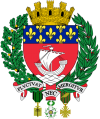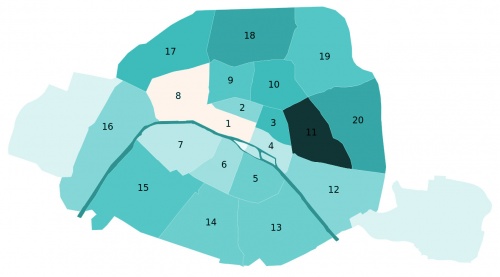Paris - La Belle Époque
- Past Imperfect -PLBE- Paris - 1933 -PLBE- Paris
Contents
- 1 Quote
- 2 Paris during the Belle Époque
- 3 Appearance
- 4 City Device
- 5 Climate
- 6 Demonym
- 7 Economy
- 8 Geography
- 9 Population
- 10 Arenas
- 11 Attractions
- 12 Bars and Clubs
- 13 Cemeteries
- 14 City Government
- 15 Crime
- 16 Citizens of the City
- 17 Corax of Paris
- 18 Current Events
- 19 Fortifications
- 20 Galleries
- 21 Gallû of Paris
- 22 Holy Ground
- 23 Hospitals
- 24 Hotels & Hostels
- 25 Landmarks
- 26 Law Enforcement
- 27 Lupines of Paris
- 28 Mages of Paris
- 29 Mass Media
- 30 Monuments
- 31 Museums
- 32 Parks
- 33 Private Residences
- 34 Restaurants
- 35 Ruins
- 36 Schools
- 37 Shopping
- 38 Telecommunications
- 39 Theaters
- 40 Transportation
- 41 Vampires of the City
- 42 Websites
Quote
In Paris, everybody wants to be an actor; nobody is content to be a spectator. -- Jean Cocteau
Paris during the Belle Époque
In Short
Paris in the Belle Époque, between 1871 and 1914, from the beginning of the Third French Republic until the First World War, saw the construction of the Eiffel Tower, the Paris Métro, the completion of the Paris Opera, and the beginning of the Basilica of Sacré-Cœur on Montmartre. Three universal expositions in 1878, 1889 and 1900 brought millions of visitors to Paris to see the latest in commerce, art and technology. Paris was the scene of the first public projection of a motion picture, and the birthplace of the Ballets Russes, Impressionism and Modern Art.
The expression Belle Époque came into use after the First World War, a nostalgic term for what seemed a simpler time of optimism, elegance and progress.
Paris 1900: La Belle Époque, l'Exposition Universelle, l'Art Nouveau (https://www.youtube.com/watch?v=8MZGusqwKPo)
Rebuilding after the Commune
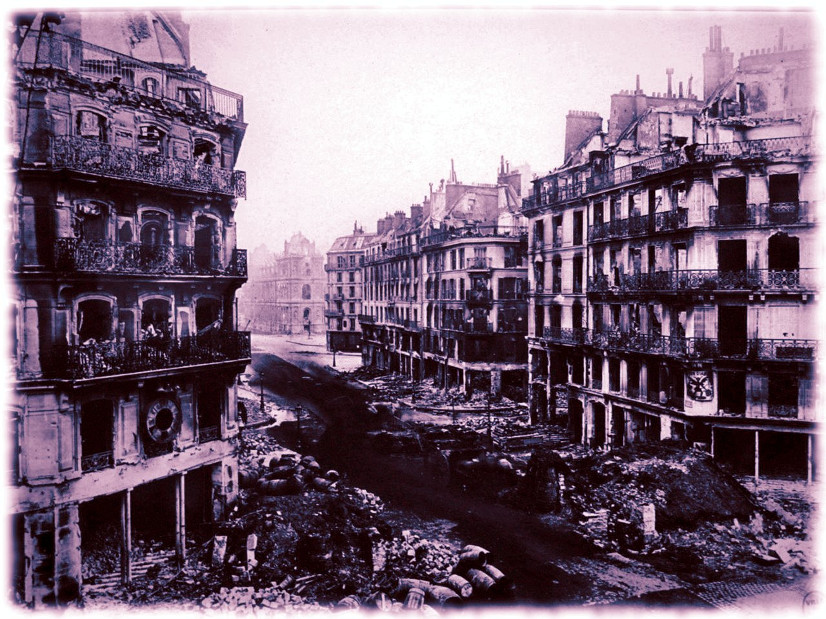
After the violent end of the Paris Commune in May 1871, the city was governed by martial law, under the strict surveillance of the national government. The government and parliament did not return to the city from Versailles until 1879, though the Senate returned earlier to its home in the Luxembourg Palace.
The end of the Commune also left the city's population deeply divided. Gustave Flaubert described the atmosphere in the city in early June 1871: "One half of the population of Paris wants to strangle the other half, and the other half has the same idea; you can read it in the eyes of people passing by." But that sentiment soon became secondary to the need to reconstruct the buildings that had been destroyed in the last days of the Commune. The Communards had burned the Hôtel de Ville (including all the city archives), the Tuileries Palace, the Palais de Justice, the Prefecture of Police, the Ministry of Finances, the Cour des Comptes, the State Council building at the Palais-Royal, and many others. Several streets, particularly the rue de Rivoli, had also been badly damaged by the fighting. The column in Place Vendôme had been toppled, on a suggestion from Gustave Courbet, a supporter of the Commune. On top of the reconstruction, the new government was obliged to pay 210 million francs in gold to the victorious German Empire as reparations for the disastrous Franco-Prussian War of 1870. On August 4, 1871, at the first meeting of the city council after the Commune, the new Prefect of the Seine, Léon Say, put forward a plan to borrow 350 million francs for reconstruction and to pay Germany. The city's bankers and businessmen quickly raised the money, and the reconstruction was soon underway.
The Conseil d'État and Palais de la Légion d'Honneur (Hôtel de Salm) were rebuilt in their original style. The new Hôtel de Ville was given a more picturesque Renaissance style than the original, borrowed from the Château de Chambord in the Loire Valley, with a facade decorated with statues of outstanding personages who contributed to the history and fame of Paris. The destroyed Ministry of Finance on the rue de Rivoli was replaced by a grand hotel, while the Ministry moved into the Richelieu wing of the Louvre, where it remained until 1989. The ruined Cour des Comptes on the left bank was replaced by the gare d'Orléans, also known under the name gare d'Orsay, now the Museé d'Orsay. The one difficult decision was the Tuileries Palace; built in the 16th century by Marie de' Medici, a royal and imperial residence. The interior had been entirely destroyed by the fire, but the walls were still largely intact, and remained standing for ten years, while the fate of the ruins was debated. Baron Haussmann, in retirement, appealed for a restoration of the building as an historic monument, and it was proposed to turn it into a new museum of modern art. But, in 1881, the new Chamber of Deputies, more sympathetic to the Commune than previous governments, decided that it was too much a symbol of the monarchy, and had the walls pulled down.
On 23 July 1873, the National Assembly endorsed the project of building a basilica at the site where the uprising of the Paris Commune had begun; it was intended to atone for the sufferings of Paris during the Franco-Prussian War and the Commune. The Basilica of Sacré-Cœur was built in the neo-Byzantine style, and paid for by public subscription. It was not finished until 1919, and quickly became one of the most recognizable landmarks in Paris.
The Parisians
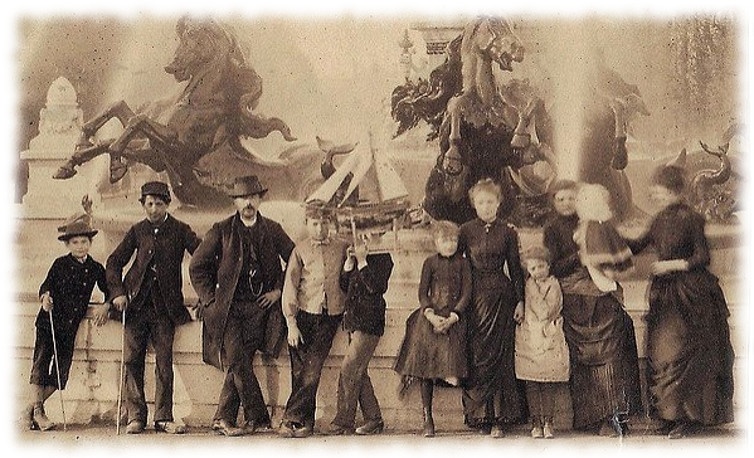
The population of Paris was 1,851,792 in 1872, at the beginning the Belle Époque. By 1911, it reached 2,888,107, higher than today's (2015) population. At the end of the Second Empire and the beginning of the Belle Époque, between 1866 and 1872, the population of Paris grew only 1.5 percent. The population surged by 14.09 percent between 1876 and 1881, then slowed down again to 3.3 percent between 1881 and 1886. After that it grew very slowly until the end of the Belle Époque, reaching its historic high of almost three million persons in 1921, before beginning a long decline until the early 21st century.
In 1886, about one-third of the population of Paris (35.7 percent) had been born in Paris. More than half 56.3 percent) had been born in other departments of France, and about eight-percent outside France. In 1891, Paris was the most cosmopolitan of European capital cities, with seventy-five foreign-born residents for every thousand inhabitants, compared with twenty-four for Saint-Petersburg, twenty-two for London and Vienna, and eleven for Berlin. The largest communities of immigrants were Belgians, Germans, Italians and Swiss, with between twenty and twenty-eight thousand persons from each country, followed by about ten thousand from Great Britain and equal number from Russia; eight thousand from Luxembourg; six thousand South Americans; and five thousand Austrians. There were 445 Africans, 439 Danes, 328 Portuguese and 298 Norwegians. Certain nationalities were concentrated in specific professions; Italians in the businesses of making ceramics, shoes, sugar and conserves; Germans in leather-working, brewing, baking and charcuterie. The Swiss and Germans were predominant in businesses making watches and clocks, and also accounted for a large proportion of the domestic servants.
The remnants of old Paris aristocracy and the new aristocracy of bankers, financiers and entrepreneurs mostly had their residences in the 8th arrondissement, from the Champs-Élysées to the Madeleine), in the quartier de l'Europe and butte Chaillot; the Faubourg Saint-Honoré, the quartier Saint-Georges, from rue Vivienne and the Palais-Royal to Roule and the plain of Monceau. On the right bank, they lived in Le Marais; on the left bank, on the south of the Latin quarter, at N(Notre-Dame-des-Champs and Odéon; near Les Invalides and at the École Militaire. The less affluent shop owners lived from porte Saint-Denis to Les Halles, to the west of boulevard de Sébastopol. The middle class employees of enterprises, small businesses and government lived closer to the center, along the Grands boulevards, in the 10th arrondissement, in the 1st and 2nd arrondissements near the Bourse (Stock Exchange), in the Sentier quarter near Les Halles, and in Le Marais.
Under Napoleon III, Haussmann had demolished the poorest, most crowded and historical neighborhoods in the center of the city to make room for the new boulevards and squares. The working-class Parisians had moved out of the center toward the edges of the city; particularly to Belleville and Ménilmontant in the east, to Clignancourt and Grandes Carrières to the north, and on the left bank to the area around the Gare d'Austerlitz, Javel and Grenelle, usually to neighborhoods that were close to their places of work. Small quarters of working-class Parisians still remained in the center of the city, on the sides of the Montagne Sainte-Geneviève in the Latin Quarter, near the Sorbonne and the Jardin des Plantes, and along the covered Bièvre River, where the tanneries had been located for centuries.
Paris was both the richest and poorest city in France. Twenty-four percent of the wealth in France was found in the Seine department, but fifty-five percent of burials of Parisians were made in the section for those unable to pay. In 1878, two-thirds of Parisians paid less than 300 francs a year for their lodging, a very small amount at the time. An 1882 study of Parisians, based on funeral costs, concluded that twenty-seven percent of Parisians were upper or middle class, while seventy-three percent were poor or indigent. Incomes varied greatly according to the neighborhood: in the 8th arrondissement, there were eight poor persons for ten upper or middle class residents; in the 13th, 19th and 20th arrondissements, there were seven or eight poor for every well-off resident.
Appearance
[[]]
City Device
Climate
Paris has a typical Western European oceanic climate which is affected by the North Atlantic Current. The overall climate throughout the year is mild and moderately wet. Summer days are usually moderately warm and pleasant with average temperatures hovering between 15 and 25 °C (59 and 77 °F), and a fair amount of sunshine. Each year, however, there are a few days where the temperature rises above 30 °C (86 °F). Some years have even witnessed some long periods of harsh summer weather, such as the heat wave of 2003 where temperatures exceeded 30 °C (86 °F) for weeks, surged up to 39 °C (102 °F) on some days and seldom cooled down at night. More recently, the average temperature for July 2011 was 17.6 °C (63.7 °F), with an average minimum temperature of 12.9 °C (55.2 °F) and an average maximum temperature of 23.7 °C (74.7 °F).
Spring and autumn have, on average, mild days and fresh nights, but are changing and unstable. Surprisingly warm or cool weather occurs frequently in both seasons. In winter, sunshine is scarce; days are cold but generally above freezing with temperatures around 7 °C (45 °F). Light night frosts are however quite common, but the temperature will dip below −5 °C (23 °F) for only a few days a year. Snowfall is uncommon, but the city sometimes sees light snow or flurries with or without accumulation.
Rain falls throughout the year. Average annual precipitation is 652 mm (25.7 in) with light rainfall fairly distributed throughout the year. The highest recorded temperature is 40.4 °C (104.7 °F) on July 28, 1948, and the lowest is a −23.9 °C (−11.0 °F) on December 10, 1879.
Demonym
Parisian
Economy
Geography
Paris is located in northern central France. By road it is 450 kilometres (280 mi) south-east of London, 287 kilometres (178 mi) south of Calais, 305 kilometres (190 mi) south-west of Brussels, 774 kilometres (481 mi) north of Marseilles, 385 kilometres (239 mi) north-east of Nantes, and 135 kilometres (84 mi) south-east of Rouen. Paris is located in the north-bending arc of the river Seine, spread widely on both banks of the river, and includes two inhabited islands, the Île Saint-Louis and the larger Île de la Cité, which forms the oldest part of the city. The river’s mouth on the English Channel (La Manche) is about 233 mi (375 km) downstream of the city. Overall, the city is relatively flat, and the lowest point is 35 m (115 ft) above sea level. Paris has several prominent hills, of which the highest is Montmartre at 130 m (427 ft). Montmartre gained its name from the martyrdom of Saint Denis, first bishop of Paris atop the "Mons Martyrum" (Martyr's mound) in 250 A.D.
Excluding the outlying parks of Bois de Boulogne and Bois de Vincennes, Paris occupies an oval measuring about 87 km2 (34 sq mi) in area, enclosed by the 35 km (22 mi) ring road, the Boulevard Périphérique. The city's last major annexation of outlying territories in 1860 not only gave it its modern form but also created the twenty clockwise-spiralling arrondissements (municipal boroughs). From the 1860 area of 78 km2 (30 sq mi), the city limits were expanded marginally to 86.9 km2 (33.6 sq mi) in the 1920s. In 1929, the Bois de Boulogne and Bois de Vincennes forest parks were officially annexed to the city, bringing its area to about 105 km2 (41 sq mi). The metropolitan area of the city is 2,300 km2 (890 sq mi).
Arrondissements
Introduction
The city of Paris is divided into twenty arrondissements municipaux, administrative districts, more simply referred to as arrondissements. These are not to be confused with departmental arrondissements, which subdivide the 101 French départements. The word "arrondissement", when applied to Paris, refers almost always to the municipal arrondissements listed below. The number of the arrondissement is indicated by the last two digits in most Parisian postal codes (75001 up to 75020).
Population
- -- City (2,714,068) - 1901 census
- -- Urban (4,000,000) - 1905 census
Arenas
Attractions
- -- Casino de Paris -- The Casino located at 16, rue de Clichy, in the 9th arrondissement, is one of the well known music halls of Paris, with a history dating back to the 18th century. Contrary to what the name might suggest, it is a performance venue, not a gambling house.
Bars and Clubs
Cemeteries
City Government
Crime
The Apaches of Paris
[[]]
Apaches was a term that was introduced by Paris newspapers in 1902 for young Parisians who engaged in petty crime and sometimes fought each other or the police. They usually lived in Belleville and Charonne. Their activities were described in lurid terms by the popular press, and they were blamed for all varieties of crime in the city. In September 1907, the newspaper Le Gaulois described an Apache as "the man who lives on the margin of society, ready to do anything, except to take a regular job, the miserable who breaks in a doorway, or stabs a passer-by for nothing, just for pleasure.
Citizens of the City
Corax of Paris
Current Events
Fortifications
Galleries
Gallû of Paris
Cleaners
Vultures
Holy Ground
Hospitals
Hotels & Hostels
Landmarks
Law Enforcement
The Paris police force was completely re-organized after the fall of Napoleon III and the Commune; the sergents de ville were replaced by the 'Gardiens de la paix publique (Guardians of the Public Peace), which by June 1871 had 7,756 men, under the authority of the Prefect of Police, named by the national government. Following a series of anarchist bombings in 1892, the number was increased to 7,000 guardians, 950 sous-brigadiers and 80 brigadiers. In 1901, under the prefect Louis Lépine, in order to keep up with the technology of the time, a unit of policemen on bicycles (called the hirondelles after the brand of the bicycles), was formed, numbering 18 per arrondissement, and reaching 600 by 1906 for the whole city. A unit of river police, the Brigade fluviale, was organized in 1900 for the Universal Exposition, as well as a unit of traffic police, who wore a symbol of a Roman chariot embroidered on the sleeve of their uniform. The first six motorcycle policemen appeared on the streets in 1906.
In addition to the Gardiens de la paix publique (Gardiens de la paix, for short), Paris was guarded by the Garde républicaine (Republican Guard), under the military command of the Gendarmerie nationale. Gendarmes had been a particular target of the Commune; 33 had been taken hostages and were executed by a (Communard) firing squad on rue Haxo on May 23, 1871, in the last days of the Commune. In June 1871, they provided security in the damaged city. They numbered 6,500 men in two regiments, plus a unit of cavalry and a dozen cannon. The number was reduced in 1873 to 4,000 men in a single regiment, called the Légion de la Garde républicaine (Legion of the Republican Guard), with its headquarters on the quai de Bourbon, and the troops quartered in several barracks around the city. The Republican Guard was given the duty of providing security for the President of the Republic at the Élysée Palace, the National Assembly and the Senate, at the prefecture of police, and also at the Opéra, theaters, public balls, racetracks, and other public places. A unit of bicyclists was formed on June 6, 1907. When World War I began, the entire unit of Paris gendarmes was mobilized and fought at the front during war; 222 of them lost their lives.
By a decree of 29 June 1912, to assure the sûreté (security) of Paris by fighting organized crime (Apaches, bande à Bonnot), a criminal section called the Brigade criminelle was created.
Lupines of Paris
Bone Gnawers
Get of Fenris
Glass Walkers
Shadow Lords
Mages of Paris
Technocracy
Tradition
Celestial Chorus
Cult of Ecstasy
Electrodyne Engineers
Order of Hermes
Verbena
Mass Media
- Le Petit Journal
- Le Jounal
- Le Petit Parisian
- Le Matin
Monuments
Museums
Parks
Private Residences
Restaurants
Ruins
Schools
Shopping
Telecommunications
Theaters
Transportation
Vampires of the City
The Legacy of Villon: The Edicts
"The Edicts are written in English for understanding, and in French for mood purpose."
L'Art / The Art
Vous ne devrez ni voler, ni détruire, ni altérer un Objet d'Art sans l'Autorisation de l'Ancien parmi les Anciens. Aucun
Objet d'Art ne doit sortir du Territoire de France sans l'Autorisation de l'Ancien parmi les Anciens.
You must not steal, destroy, or alter an Object of Art without the Authorization of the Eldest among you.
No Object of Art is to exit the domain of France without the Authorization of the Eldest among you.
L'Elysée / The Elysium
Les Lieux protégé par l'Elysée ne pourront être le théatre de violence, ni de la Chasse. Provoquer la violence ou Chasser
dans l'Elysée sans l'Autorisation de l'Ancien parmi les Anciens est passible d'une Chasse de Sang. Par mesure de sécurité,
l'accès de certains Elysées sera réglementé.
Grounds protected by the Elysium will not be sullied by violence of hunt. Provoke violence or hunting in an Elysium
without the authorization of the Eldest among you can be punished by the Blood Hunt. For security reasons, the access to
some Elysiums will be limited.
L'Ordre / Order
L'ordre doit être garanti par le Prince, qui s'approprie donc de manière exclusive les moyens d'assurer
l'ordre et le bien-être de la Famille comme du Bétail. Il est par consécquent formellement interdit d'influencer
les forces de polices et les forces armées.
Les Masques et les Veilleurs, étant les representants du Prince, ne sont pas soumis à cet Edit.
Order is to be guarranteed by the Prince, who thus gather exclusively for himself the means to warrant the order and well
being of Kindred and Kine. Thus it is strictly forbidden to influence the police and army forces.
The Masques, being the representatives of the Prince, are not submitted to this Edict.
Diablerie / Diablerie
La Diablerie est un acte infâme indigne de notre Condition. Tout Caïnite convaincu de Diablerie sera passible d'une Chasse
de Sang, et ce, quel qu'ait été le Calice, ou l'endroit du crime.
Diablerie is an atrocious action under our condition. Any Kindred guilty of Diablerie can be Blood Hunted,
no matter who was the victim and where it happened.
L'Amaranthe / The Amaranth
Ceux qui se seront montré particulièrement indigne de leur Sang pourront voir leur Sang arraché par l'Amaranthe. Seuls
ceux qui auront été dignes des Traditions et Edits de Paris pourront se voir peut-être accordé par l'Ancien parmis les
Anciens, l'Amaranthe.
Those who acted in ways unworthy of their Blood can be subject to the Amaranth. Those who acted in ways worthy of their
Blood and of the Traditions and Edicts can be given the right of Amaranth by the Eldest among you.
La Magye / The Magick
Pratiquer les rituels magiques en présence d'un Mage est strictement interdit, tout comme tout contact avec eux.
Leur guerre d'ascension n'est pas la nôtre. Clan Tremere Le retour à Paris est conditionné par le comportement de leurs membres.
Les Veilleurs ne sont pas soumis à cet édit.
Praticing magic rituals in presence of a Mage is strictly forbidden, as is any contact with them. Their Ascensíon war is not our own. Clan Tremere Returning to
Paris is conditioned by the behaviour of their members.
The Veilleurs are not submitted to this Edict.
Assamites
Brujah
- -- Benedicte Dalouche -- Currently in Berlin...but wanting to return.
- -- L'Homme de Peu de Foi
- -- Saint Just 8th Generation, childe of Robin Leeland, sire of Karl.
- -- Thomas Frère(Thomas, Brother); 6th Generation Duc of the Brujah.
The Bâtards/ Catiff
Daughters of Cacophony
Followers of Set
- -- Theti-Sheri
- -- Samson Aersenns
Gangrel
- -- Niels Frank; - Progeny of Lord William Harper
- -- Jaques La Pul; - Childe of Niels Frank
- -- Jean-Luc Laupier - Progeny of Lord William Harper
Malkavian
- -- Henrique
- -- Rochelle Dalmar
- -- Pierre Lavosh
Nosferatu
Toreador
- - Francois Villon -- Domain: The Louvre {Location: Right Bank of the Seine in the 1st arrondissement.}
- - Arnaud -- Domain: Club Elysée {Location: 8th Arrondissement}
- - Carla Gagnon -- Domain: Église de Saint-Nicolas-du-Chardonnet {Location: 5th Arrondissement}
- - Maxime -- Domain: Saint-Georges -- A neighborhood of Pigalle -- Maxime has a loft above the vaunted SACEM building that he uses as his haven. {Location: 9th Arrondissement}
- - Bernard -- Domain: The Louvre {Location: Right Bank of the Seine in the 1st arrondissement.} -- As the Seneschal of Paris, Bernard resides with his sire in the Louvre.
- - Chevalier d'Eglantine -- Domain: Les Invalides {Location: 7th Arrondissement}
- Merevith
- - Elle Emilie Nicoline
- - Lazlo Guerin -- Domain: Palais Bourbon {Location: 7th Arrondissement}
- - Florient (Deceased)
- - Versancia
- - Violetta Desjardins
- - Arnaud -- Domain: Club Elysée {Location: 8th Arrondissement}
Tremere
- -- Lazare Monet -- Creator of La Transsubstantiation de la Cuisine.
- -- Czere Ubireg -- Turkish Apprentice
True Brujah
Ventrue
Websites
https://en.wikipedia.org/wiki/Paris_between_the_Wars_(1919%E2%80%931939)
https://en.wikipedia.org/wiki/Belle_%C3%89poque
https://en.wikipedia.org/wiki/Paris_in_the_Belle_%C3%89poque
